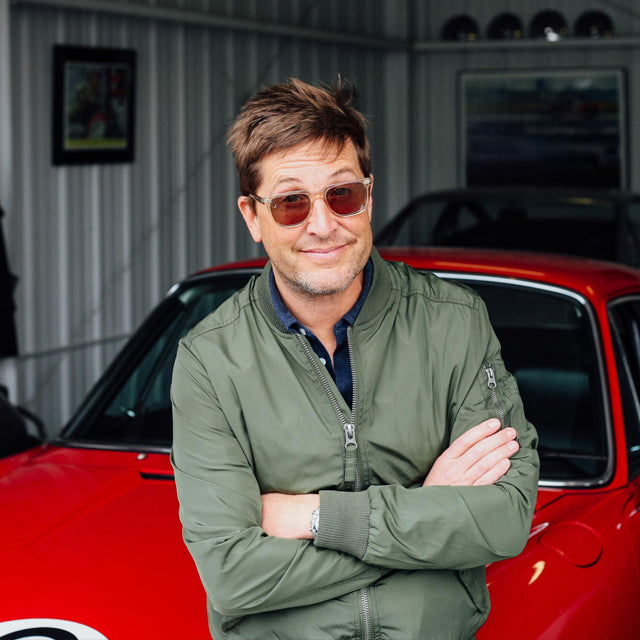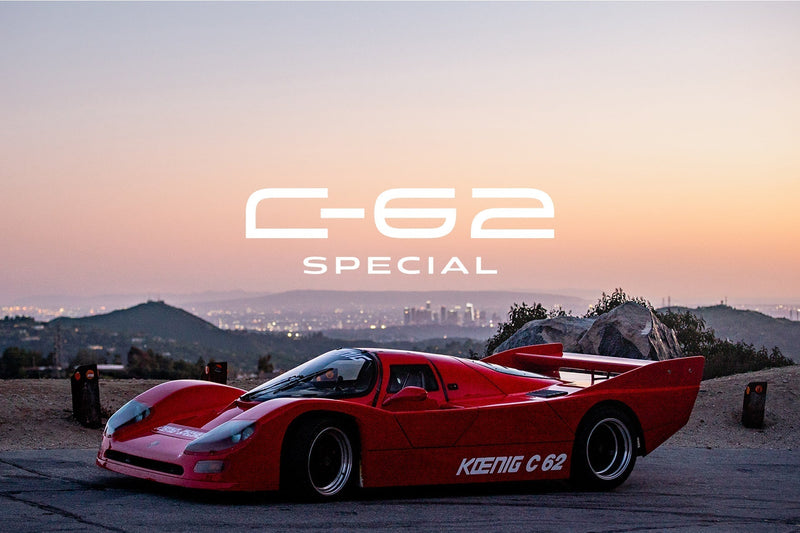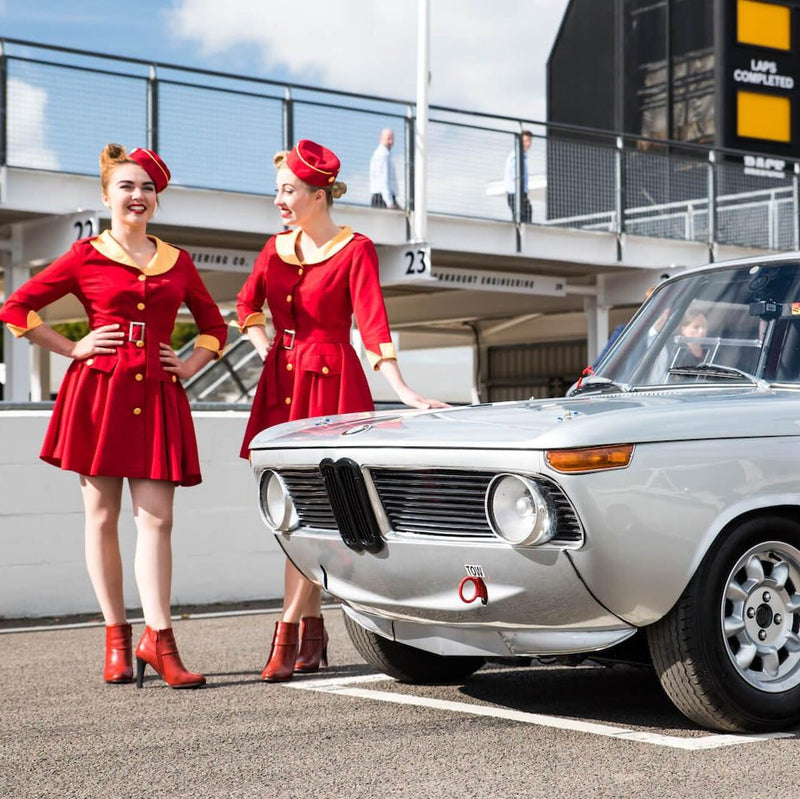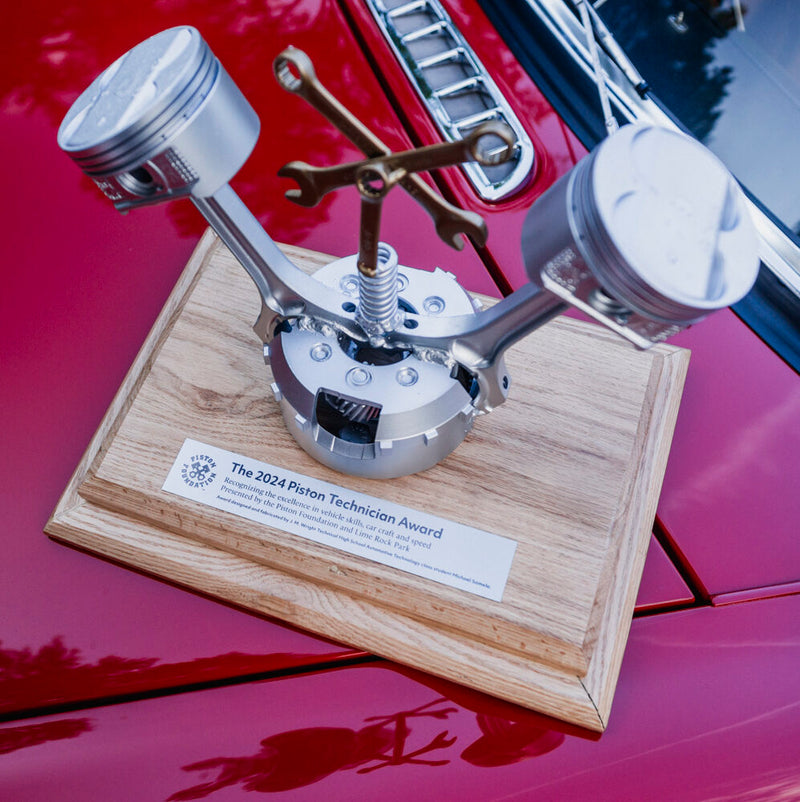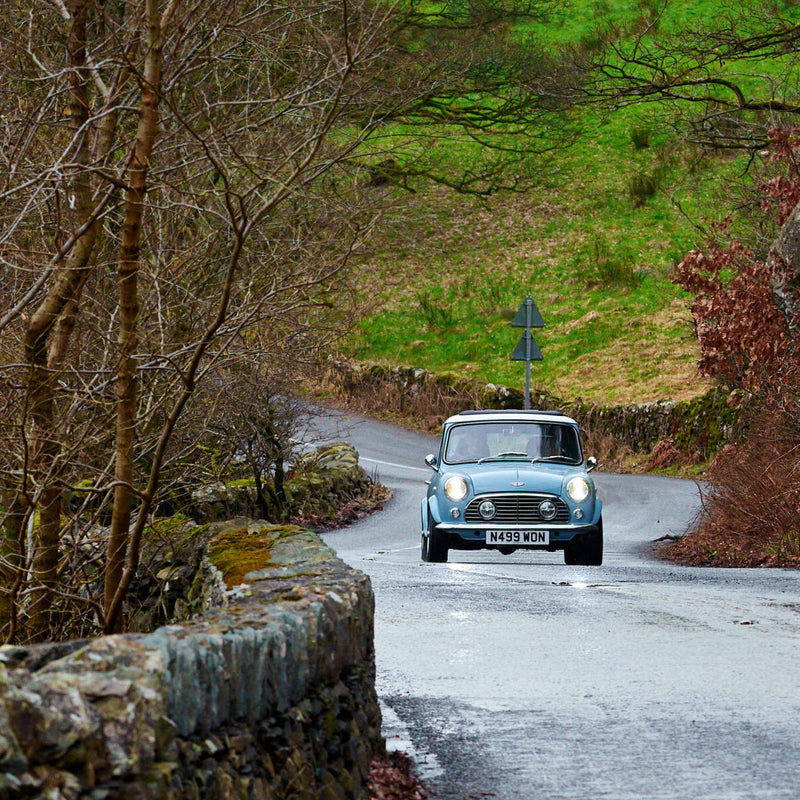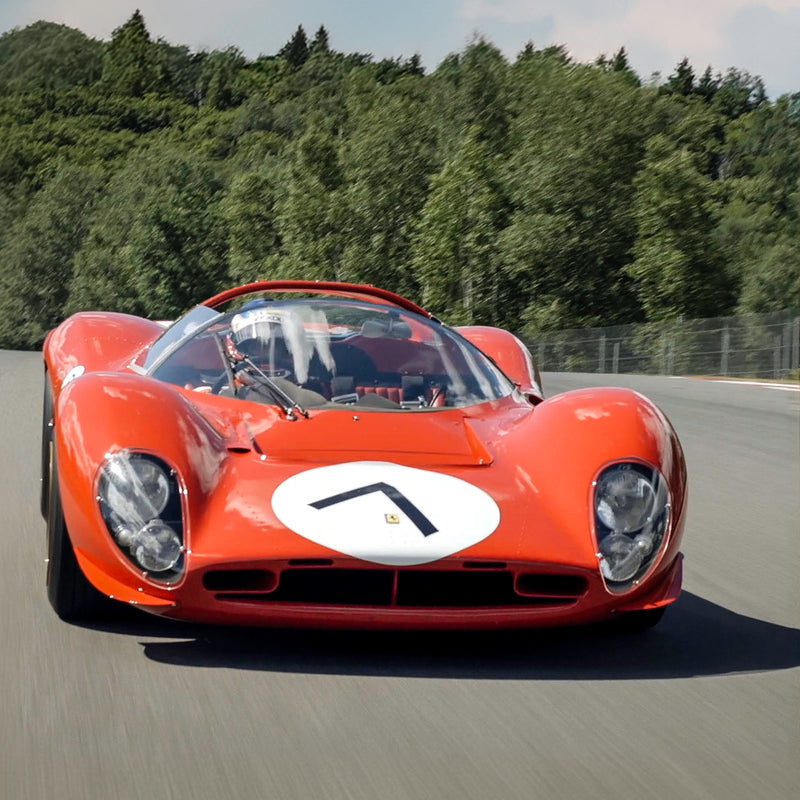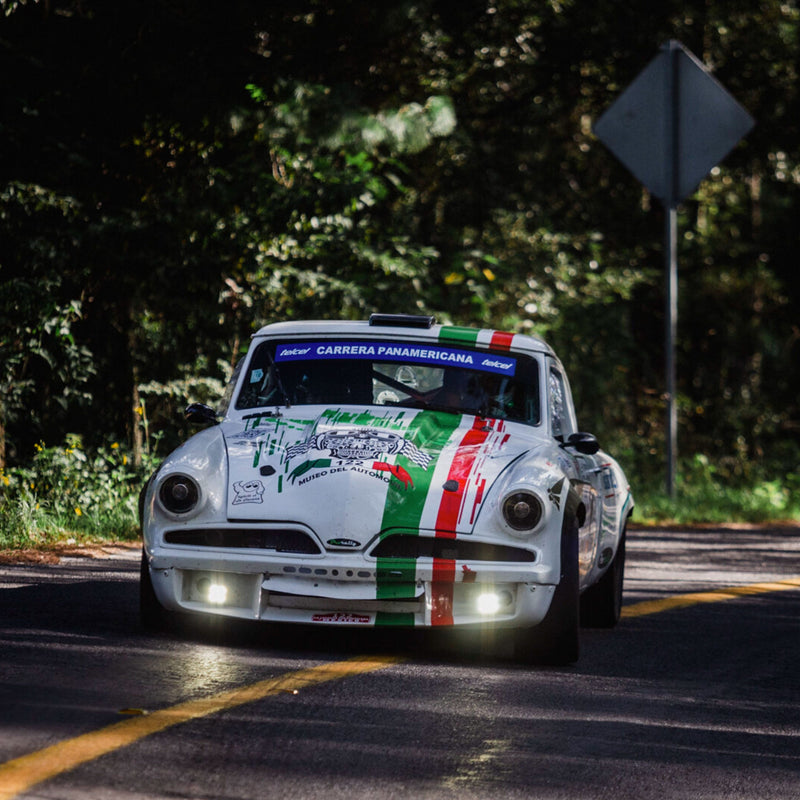Michael Donovan “Spike” Feresten Jr. is a man who—for some—will need an introduction. At different points in his career he’s played massive roles both in front and behind the camera, claiming responsibility for some of the most iconic moments in entertainment history. Have you ever referenced the “Soup Nazi” or “Muffin Top” episodes of Seinfeld? That was Spike. Did you ever laugh at Mujibur Rahman and Sirajul Islam on Letterman? Spike, again.
Early on in his writing career, in a manner of speaking, David Letterman spiked Feresten’s love for cars by tossing over the keys to his Dino, igniting a passion for machines. All of this leads up to his most recent show on Esquire TV, appropriately dubbed Car Matchmaker, wherein he quite literally matches people with cars while cracking them up.
Spike invited me ’round one recent afternoon to his hangar at the Santa Monica Airport to fondle his collection and catch up, and I’m very glad he did.


Ted Gushue: What was your first car?
Spike Feresten: I think most people have two first cars. Their actual first car and the first car they desired, saved for, then bought. When I was 17, my dad bought my brother and I a beaten down 1971 Ford Torino 500 with unspecified miles. It wasn’t long before my bro wrapped it around a telephone pole and I had no car again. The first vehicle I desired and bought was actually a motorcycle. It was a Kawasaki Ninja ZX600. This is what I drove rain, shine, sleet and snow during my college years in Boston.
TG: Why Kawasaki?
SF: There was a Kawasaki dealer in my hometown in Massachusetts. We passed it every time we drove to the K-Mart. We covet what we see. My uncle had also crashed his Kawa-dog and at the time I thought that was so cool. My first new car was the brand new Porsche Boxster. When I saw the concept car, I lost my mind. I became obsessive about saving to buy one. Fortunately, I was writing for Letterman at the time and was making decent money.
TG: What was the sticker price on a Boxster back then?
SF: Gosh, I don't recall. Around $40k Usd., plus options. Here's where it gets good: by the time I had saved the money, I was writing for Jerry Seinfeld, and he was able to hook us up with the first Boxsters delivered to California.
TG: So at this point, he’d been well-established in the Porsche Community, yes?
SF: Yeah. He had an “in” at Circle Porsche in Long Beach. The day we picked them up, we took this very memorable drive from Long Beach back to the CBS Radford Studios. Racing up the 405 in these silver cabriolet space ships. People kept asking us, "Which end is the front and which is the back? What is that?” It was such a revolutionary design that folks had no idea what they were looking at.


TG: What color was yours?
SF: Mine was silver-black and I believe his was silver-red.
TG: Had you met Jerry through Porsches before you started writing for him?
SF: We met on the comedy scene. In the Letterman offices. I never considered myself part of the Porsche community until after working on Seinfeld. I grew up in a small blue-collar town. We drove American muscle cars. That's what we were all about. I wasn't very knowledgable about exotic cars in general. No internet back then. It wasn’t until I bumped into David Letterman and he let me drive his exotic collection at this very airport in 1991 that I discovered cars like the Ferrari Dino and the 4-cam Porsche 356 Speedster. I drove them and my judgmental Massachusetts attitude about them evaporated. I had thought these were cars for assholes, and they are , but there's also a simplicity and elegance to them. On old Porsches in particular, there was nothing extra. They're spartan and light without power steering or brakes. It hit me like a lightning bolt.
TG: Do you think that your love for automobiles was accelerated by the people that introduced you to them?
SF: Yeah, yeah, just like meeting a drug dealer. He opens up the briefcase and says, “Hey kid, have you ever considered these?”
TG: Right. I have to imagine that if David Letterman handed you the keys to his Dino it's very different experience then if your buddy down the street handed you the keys to his 928.
SF: I remember his exact words. He said, “Wait until you hear the sound it makes, this car is going to make you laugh." And sure enough, as I blasted down Ocean Park Boulevard, I was laughing out loud. A lot of my collection over the years is based on the cars that were in Dave's hanger that day. Particularly the Speedster and the Dino.
TG: After the Boxster you bought the Speedster? Is that right?


SF: It's all a blur at this point. I started out with 1974 beater 911. It was sepia brown with a brown interior. An awful color combination. Frankly, it was a death trap. When Seinfeld saw it in our parking lot, he was so excited that there was a Porsche guy on the writing staff, but he told me that particular Porsche has to go. Since he was my boss, he made me donate the car to the Make-A-Wish Foundation the next day and got to work hunting down better examples. This is very easy to do when you're near Jerry. So many cars pass under his nose on any given week, that all you need to do is stay next to him with a checkbook. Suddenly, I needed more garage space so I'm hooked up with a hangar at Santa Monica Airport and well, there goes my savings plan.
TG: That's when you know you have a problem.
SF: Right; because when you look into that hanger, you see empty spots that must be filled with cars. I don't care who you are, a collector’s collection size is dictated by the size of his storage space. If we could convince homebuilders in America to add four car garages to every new home, car sales would double in this country.
TG: Do you drive any of the cars that have skyrocketed in value differently?
SF: No. Nope. I drive everything the same. There are cars that I don't give to valets. Like this Volkswagen police car sitting right here. It's not a very valuable car, but it’s so cool and I don't feel like spending a month of my life trying to track down ’70s German police car parts. I just want to drive the damn thing.
TG: What do you spend the most time in?
SF: Of late, it’s been that Ferrari, that ’72 GTC4, and the 991 GT3. Those are two cars I never want to bring back to the hanger.
TG: What's the story with the 911 L?
SF: I was looking for a ’60s 911. That’s all I knew, the 911. So I called my friend Sam Cabiglio and asked if he knew of anything unique or rare on the market. He told me about this lightweight factory race car from 1968. It was raced by a fellow named Fred Baker in the ’68–’69 Trans Am series, once co-driven by Dickie Smothers of the Smothers Brothers.
So it had a comedy provenance like me. He goes, "But, it was offered to me two years ago. You want me to call the guy and see if it’s still for sale?" The market was red hot so I doubted it, but what the hell. Let’s check I said. So we call this guy and he says, “Why yes, I never really brought the car market, but we're about to. Would you like to come see it at TRE Motorsports in the valley?” The next day we went down there. We saw this car and bought it on the spot. It was exactly what I was looking for, even though I had no idea what I was looking for. It was also the very same car on one of my favorite Porsche factory posters.

TG: Quite the coincidence.
SF: It's a stripped-out factory race car from the late 60s. One of five they say.
TG: It must be just a scream to drive.
SF: It's loud as hell. It's a race car with a license plate and I can't believe the state of California lets me drive it on their roads. God bless the state of California, because this shit did not happen in Massachusetts. If I dropped my kids off for school in a race car in Massachusetts, they’d have me in the village stocks by noon.
TG: So talk to me about how that got started with your current show.
SF: The show is call Car Matchmaker. It's on Esquire network. Obviously, there are car guys reading this. They read Petrolicious, and they're the people in their neighborhood or in their family who people get asked for car help.

TG: Sure.
SF: Right? I do the same thing. To a lot of friends, famous friends, my wife, my agent and my neighbors, I’m the guy they turn to for advice. I’ve had a lot of luck getting them to pull the trigger. A producer who I had recently helped asked me if I'd be ever interested in doing a show where I help people find cars. I thought, “I can finally monetize this stuff!” We walked into Esquire, now we're cruising into our third season. I love every minute of it. It’s one of those dream jobs that doesn’t come along often in life.
TG: How do you look at the success of Comedians in Cars Getting Coffee? What does that mean for our community?
SF: I mean, the fact that Seinfeld got the President of the United States to drive a Corvette. That moment elevated this car thing of ours. That the Commander-in-Chief is doing an episode of Comedians in Cars Getting Coffee and talking Corvettes… It speaks to just how big this thing is. I remember a day, maybe 20 years ago, when we were almost apologetic that we were car guys. It was embarrassing.
TG: Of course.
SF: It was like, “I know it's stupid, but yeah, I'm a car guy. I like cars. Sorry. I’ll be hiding in the garage.” Now, the internet has connected all of us, and we see we're a worldwide phenomenon. Growing faster than the Muslim religion! For me it's about community and it's about driving. It's about a shared love for these vehicles whether it's something you bought for a few hundred dollars or a hundred mill. That’s it. I’m changing my name to Spike-a-licious, and you’re not talking me out of it!
Thanks to Spike for inviting us over to talk cars. You can read more about his show Car Matchmaker on Esquire—and, of course: follow him on Instagram, Twitter, and Facebook.


